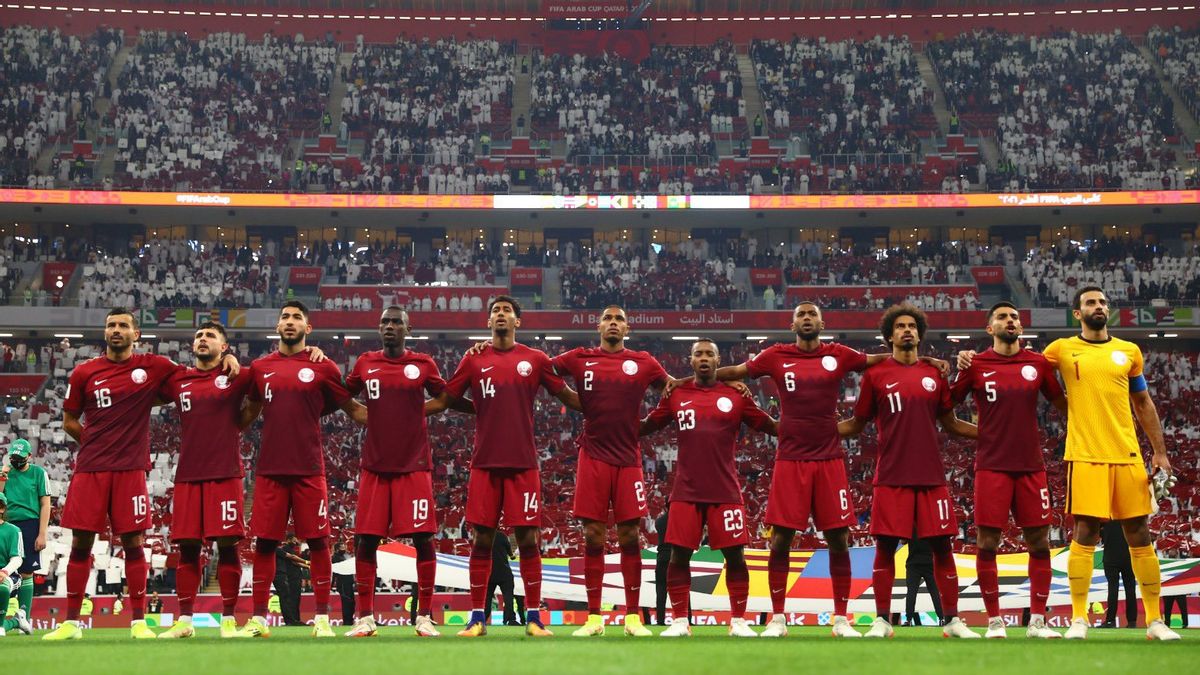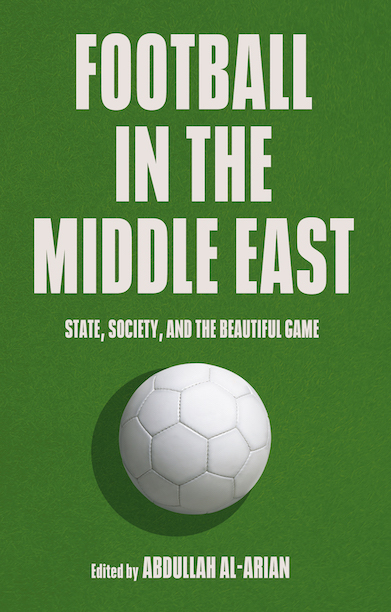
Football in the Middle East: State, Society, and the Beautiful Game, edited by Abdullah Al-Arian
Hurst Publishers (2022)
ISBN 9781787387133
Justin Olivier Salhani
It was in 2010 that the International Federation of Association Football (FIFA) announced that Qatar would host the 2022 World Cup. Almost immediately, the selection of the gas-rich Gulf Arab state with a population of just over one million people ignited controversy. It led to a shakeup within FIFA itself that blighted the reputation of its president, Sepp Blatter, and ultimately led to the end of his tenure. Yet the controversy has continued. With the World Cup having just kicked off, there seems to be less attention paid to the teams and players as there is to the hosts.

When discussing Qatar as a host for the World Cup, it can be difficult to know where to stand. There’s been a barrage of both good faith and bad faith criticism. Good faith arguments tend to center migrant workers and violations of their rights. Bad faith criticisms might include Orientalist or racist undertones. Sometimes, there are good faith criticisms of the bad faith criticisms. Yet often the bad faith criticisms are highlighted to dismiss any, and all, criticism.
This is important to keep in mind when reading Football in the Middle East: State, Society, and the Beautiful Game, an anthology of twelve chapters written by various academics and journalists, and curated by Abdullah Al-Arian, an associate professor of history at Georgetown University in Qatar.
Examining the relationship between football and politics, the book spans North Africa, the Levant, Turkey, Iran, and the countries of the Gulf Cooperation Council (GCC), of which Qatar is one. Of the twelve chapters, three focus on Qatar, with an additional one looking at the GCC more generally.
There are superb contributions here, including discussions of the vastly unequal treatment of women footballers in Turkey compared to their male counterparts (Yağmur Nuhrat), the unique form of discrimination suffered by Palestinian footballers in Lebanon (Danyel Reiche), football and the transnational Boycott, Divestment and Sanctions movement for Palestine (Aubrey Bloomfield), and the impact of social media on women’s struggle to attend football matches in Iran (Niki Akhavan). In fact, one of the most succinct descriptions of football in the region comes from this last:
The continued political and social contestation centered on football games […] captures the position in which the state finds itself: caught between the benefits of football for engaging the population and allowing the state to legitimize its policies and the downside of football as a site where demands are made on the state.
One might also mention the chapter by Maher Mezahi (full disclosure: Mezahi is a friend) on the history that led to Algeria’s 2019 Hirak movement. He takes the reader on a journey from popular cafes to the football stadium and out into street protests. Connecting the three, he shows how hardcore football fans, commonly known as ultras, contributed to anti-government protests through popular chants, music, large choreographic displays referred to as tifos, and graffiti.
The most thought-provoking chapter is the anthology’s first, titled “The Political Game: A Genealogy of the Egyptian League,” by Ibrahim Elhoudaiby. This entry covers the origins of the Egyptian football league and the class and colonial dynamics at play in the early days of the sport in Egypt, from British occupation to independence. Elhoudaiby reframes the relationship between sport and politics by arguing that the latter is not only inseparable from the former, but also that professional football is “a political terrain in its own right.” He also explains how football was used by the British as a means of colonial subjugation:
Targeted colonial subjects were not peasants or urban poor playing on the streets, but effendis — the colonially educated middle-class men who were to be disciplined into civilized imperial citizens. Second, mixing with the colonial subjects on playing fields was a means of emphasizing colonial difference. It was an expression of British superiority manifest in their mastery of team tactics and individual self-discipline. Colonial discourses had deemed the Egyptian body “weaker, less disciplined, and insufficiently masculine” and therefore unfit for national service, and British superiority on the field validated these claims.
Sitting uncomfortably alongside the aforementioned entries are others of considerably less merit. Those on Qatar emerge as the main offenders. While many of the chapters in Football in the Middle East, including Al-Arian’s, share research on people in the region fighting for freedom from oppression, or people who are overlooked by their country’s ruling powers, those focused on Qatar are more concerned with deflecting criticism of the country’s regime or defending it outright.
This shortcoming is most unfortunate, particularly as the issues of soft power and “sportswashing” (whether or not explicitly identified as such) figure prominently in the book. In editor Al-Arian’s own chapter, “Beyond Soft Power: Football as a Form of Regime Legitimation,” which examines how football’s power and influence are often enlisted in the service of state-building, he defines sportswashing as states using “their promotion of football to counteract international isolation and negative publicity resulting from damaging policies in other arenas.” In addition to describing George W. Bush’s political use of the Iraqi national football team’s successes during his time as president of the country that invaded Iraq, he is not averse to discussing the subject within the context of the Arab Gulf.
For example, Al-Arian highlights the UAE’s penchant for repression both on the domestic front and in terms of which Arab regimes or movements abroad it supports. And he has the following to say about Saudi Arabia’s problematic involvement in international sport:
Saudi Arabia has actively stepped up its investments in football, for instance by hosting both the Italian and Spanish domestic cup final matches and the purchase of English club Newcastle United by the state-owned Public Investment Fund. Concurrently, the Saudi regime has waged a destructive war in Yemen and carried out a violent campaign to repress dissent at home and abroad.
What, then, of Qatar? Even as Al-Arian aptly describes Saudi and the UAE’s attempts to use sport to whitewash their repression of freedoms at home and their adventurism abroad, he does not subject Qatar to the same sort of scrutiny, whether in terms of its hosting the World Cup or its acquisition of a European football club. Al-Arian’s is the book’s second chapter; it is a sign of things to come.
In “Homeland: National Identity Performance in the Qatar National Team,” Thomas Ross Griffin pursues a somewhat different approach, albeit one similarly characterized by omission. What Griffin conspicuously leaves out of his dissection of Qatar’s national football team members’ patriotism is that Qatar is an autocratic state. The author breaks down the team into three categories: full Qatari citizens (jus sanguinis), long-term residents born in Qatar (jus soli), and players naturalized to represent Qatar (jus talenti). Griffin finds that despite the differing categories, the displays of patriotism and reverence for Qatar’s Emir Tamim bin Hamad Al Thani show little variation.
This was most notable, he states, during the 2017 blockade of Qatar by its Gulf neighbors, when public displays of Qatari patriotism surged. “Qatar players wore t-shirts with the Tamim Al-Majd [Tamim is glory — ed.] image emblazoned across the front,” Griffin writes of a 2018 World Cup qualifier against South Korea. “What is crucial to note in this performance of social nationalism during such an extraordinary moment in Qatar’s history,” the author continues, “is that every player participated in this very public performance of Qatari identity. It was not just those in the jus sanguinis group.”
Griffin may be right. Yet, aside from the fact that he seems to conflate patriotism and reverence for one’s ruler, such reverence for a ruler none of the players have any say in electing does not seem to strike him as at all bizarre. Separately, he concurs with Qatar’s view of itself as “a modern, open” nation —without noting the rights it denies its citizens, including those in the supposedly enviable jus sanguinis group.
Whereas Griffin fails to properly lay out the reality of an autocratic state, Zahra Babar’s chapter, “Qatar, the World Cup, and the Global Campaign for Migrant Workers’ Rights,” goes one step further. Babar boldly defends Qatar’s labor reforms in the face of widespread criticism. This is ironic. True, under pressure, Qatar dismantled its kafala system, in which foreign workers’ visas were sponsored by local citizens or companies, meaning that these foreigners’ legal presence was entirely dependent on an employer and open to exploitation. Yet thousands of migrant laborers have died in Qatar since 2010, many of them working on infrastructure related to the World Cup. While the Qatari government has said many of these deaths are from natural causes, the uncertainty around the issue stems from Doha’s failure to make data available to researchers or rights groups. Instead, the government has classified many deaths as cardiac arrests — a manner or mode, but not a cause, of death — or simply determined them to be “unexplained.”
Moreover, according to advocacy organization Migrant Rights, kafala is “still alive,” even if unofficially. Babar herself acknowledges that “[t]he largest infrastructural projects in Qatar that require labor input from migrants are state-led. […] With such an intense blurring of boundaries between ‘state’ and ‘business,’ it is disingenuous for the state to posit that it is not accountable for labor violations that occur.”
One of Babar’s central arguments is that international human rights groups would have been better served spending the last twelve years building relationships with Qataris in an effort to spur change, instead of leveling criticisms at the Qatari government. This comes across as somewhat cavalier. After all, connecting with Qatari activists could endanger them; many Qataris who have spoken out about political or human rights have been jailed, sometimes with life sentences. As for non-citizen workers’ rights activists in a country in which trade unions are illegal, one has only to look at the case of Kenyan blogger Malcolm Bidali — whom Babar fails to mention. On May 4, 2021, Bidali was forcibly disappeared after blogging about his experience as a security guard in Qatar and the plight of other foreign workers. After 26 days in solitary confinement, Bidali was obliged to pay a hefty fine and deported.
Another chapter that proves problematic is Simon Chadwick’s “GCC Football Fans and Their Engagement: Establishing a Research Agenda.” Early on, the author correctly dismisses Orientalist critiques of Gulf Arabs that portray them as lacking adequate passion for the game and consequently claim that they would make for unsuitable World Cup hosts: “Such views are at best naïve or perhaps ill-informed, but at worst they are patronizing, condescending, and reflect a troubling xenophobia.”
This is about as informative as Chadwick gets in his chapter, the crux of which is dedicated to proving that research on GCC football culture is “insufficiently diverse in its foundation and focus, as it fails to account for the distinctiveness of engagement across the region.” While it is true that there is a paucity of scholarship on sports fandom in the GCC, simply pointing this out, without venturing into the realm oneself, serves little purpose. Saying “I don’t know” might be honest, but doing so in a chapter of a book about football in the Middle East, rather than before one is assigned to write said chapter, is curious. Then again, perhaps this is a deliberate, and evasive, maneuver.
Indeed, though this book includes illuminating chapters on subjects of great importance both in and to the Middle East, insofar as Qatar is concerned, the goal appears to be obfuscation. To be sure, nuance is always welcome. Many issues are not without moral or ethical complications, and the World Cup in Qatar is at times subjected to simplistic analysis. When it comes to the rights of migrant workers and local minorities, however, the moral toll of looking away or equivocating is abundantly clear.
Football in the Middle East contains much of value in many of its pages. But readers keen for pertinent information and insightful analysis on Qatar would do better to look elsewhere.


































